Thomas Jefferson Worksheets
Do you want to save dozens of hours in time? Get your evenings and weekends back? Be able to teach about Thomas Jefferson to your students?
Our worksheet bundle includes a fact file and printable worksheets and student activities. Perfect for both the classroom and homeschooling!
Resource Examples
Click any of the example images below to view a larger version.
Fact File
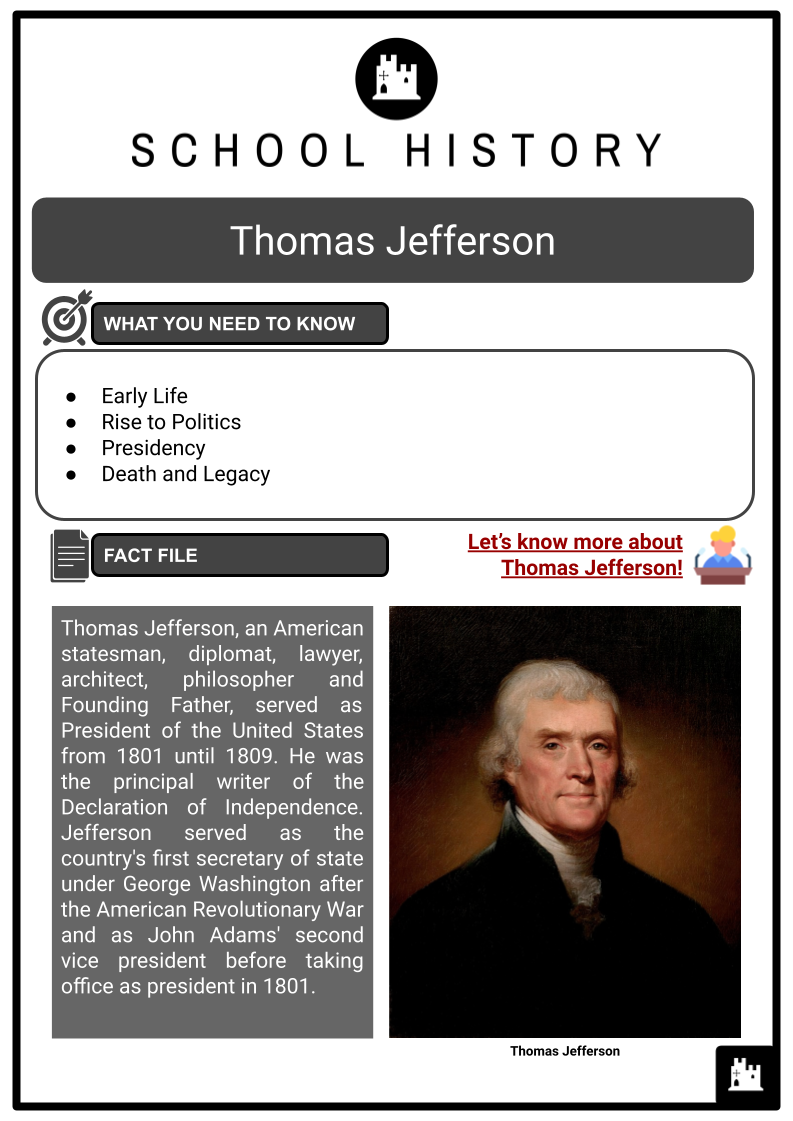
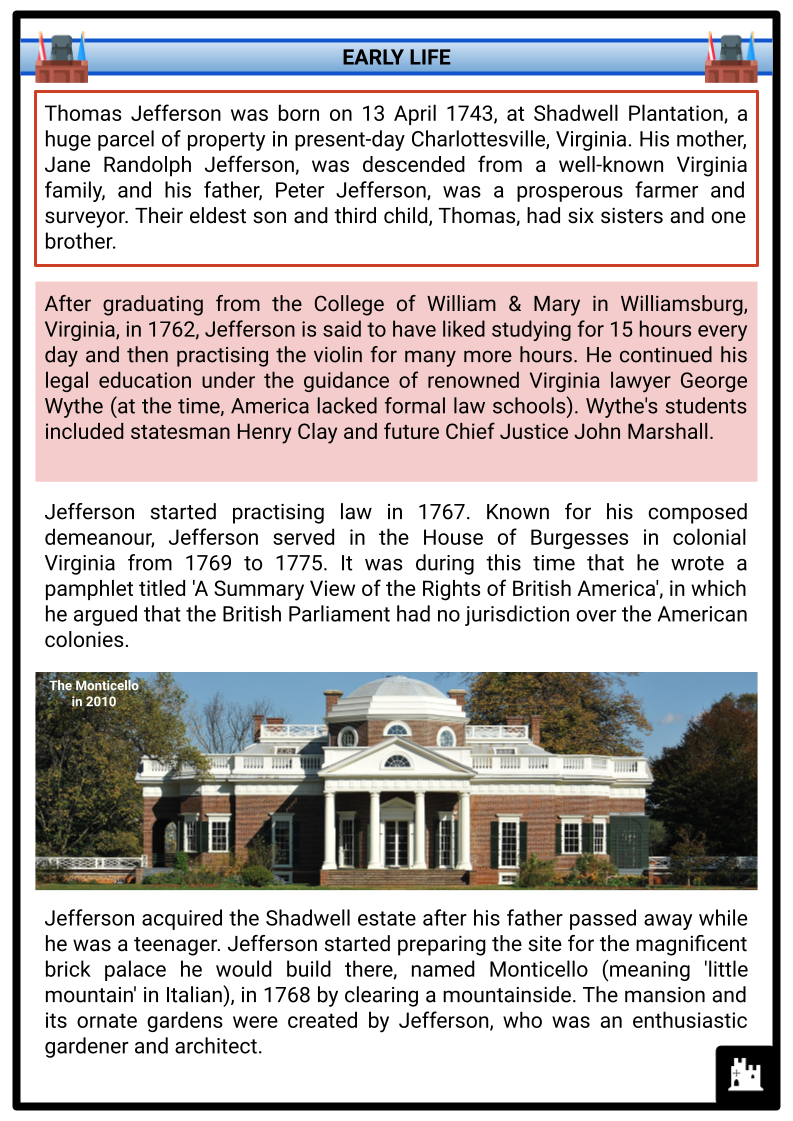
Student Activities
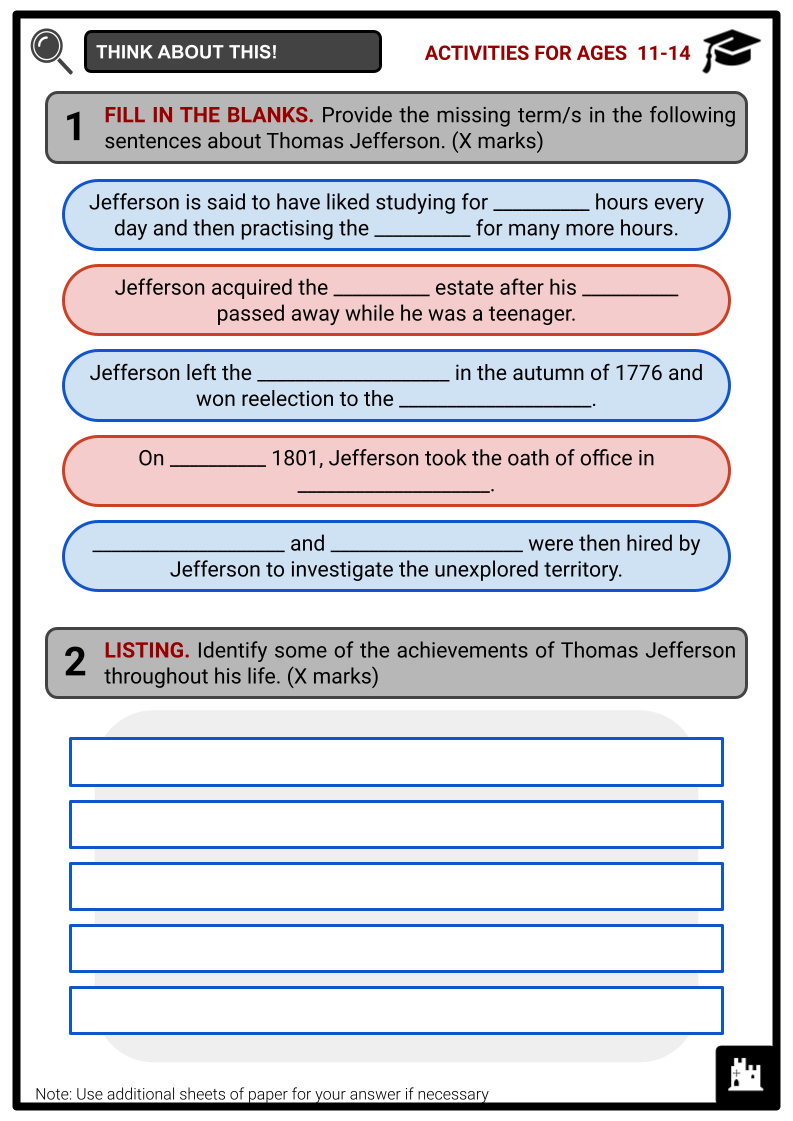
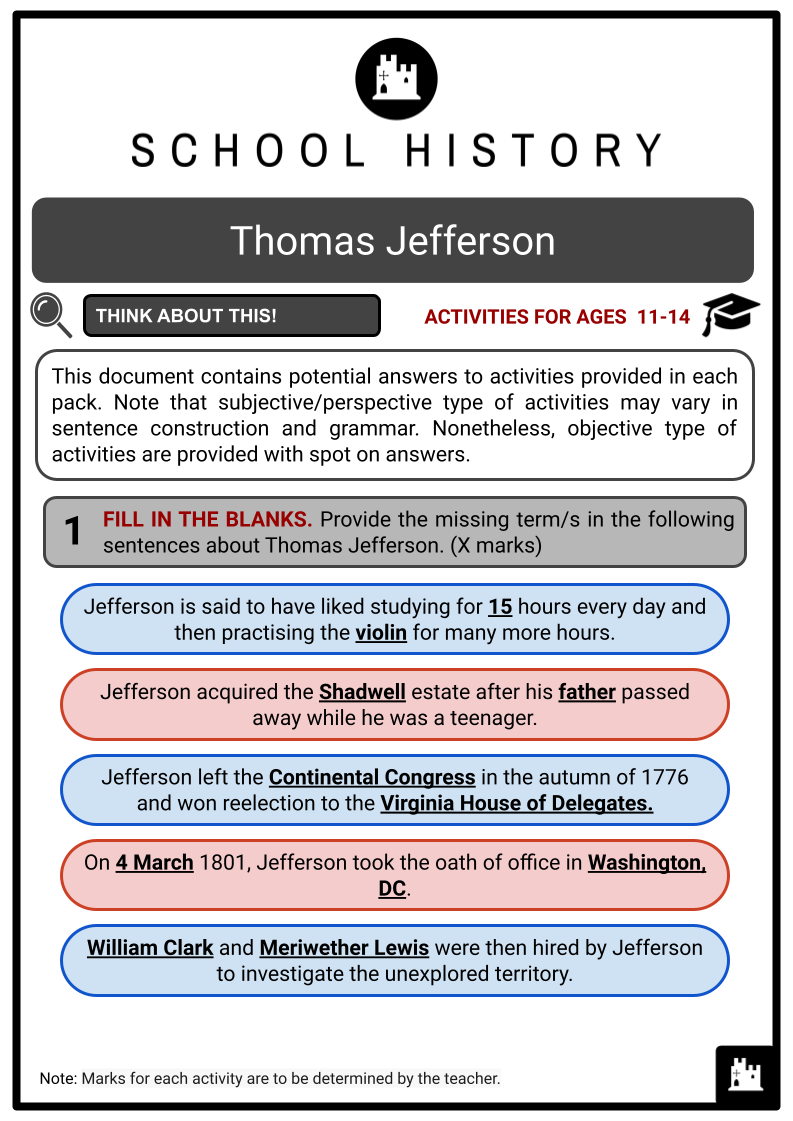
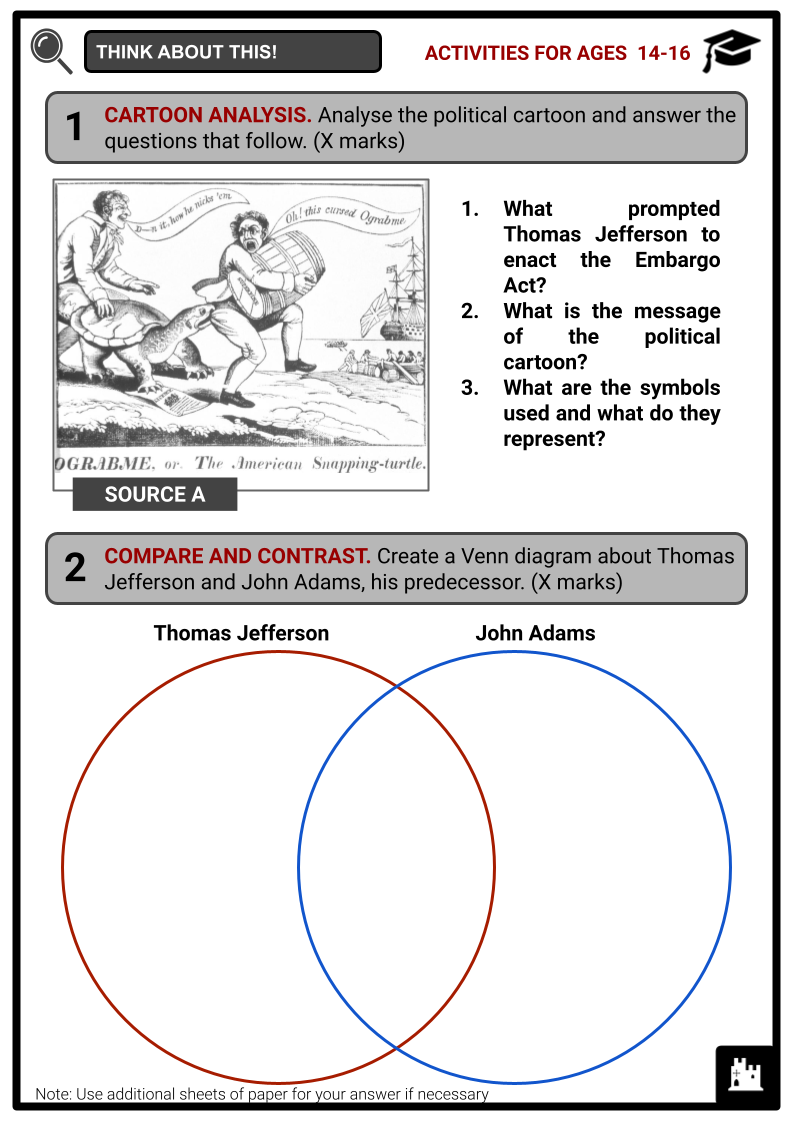
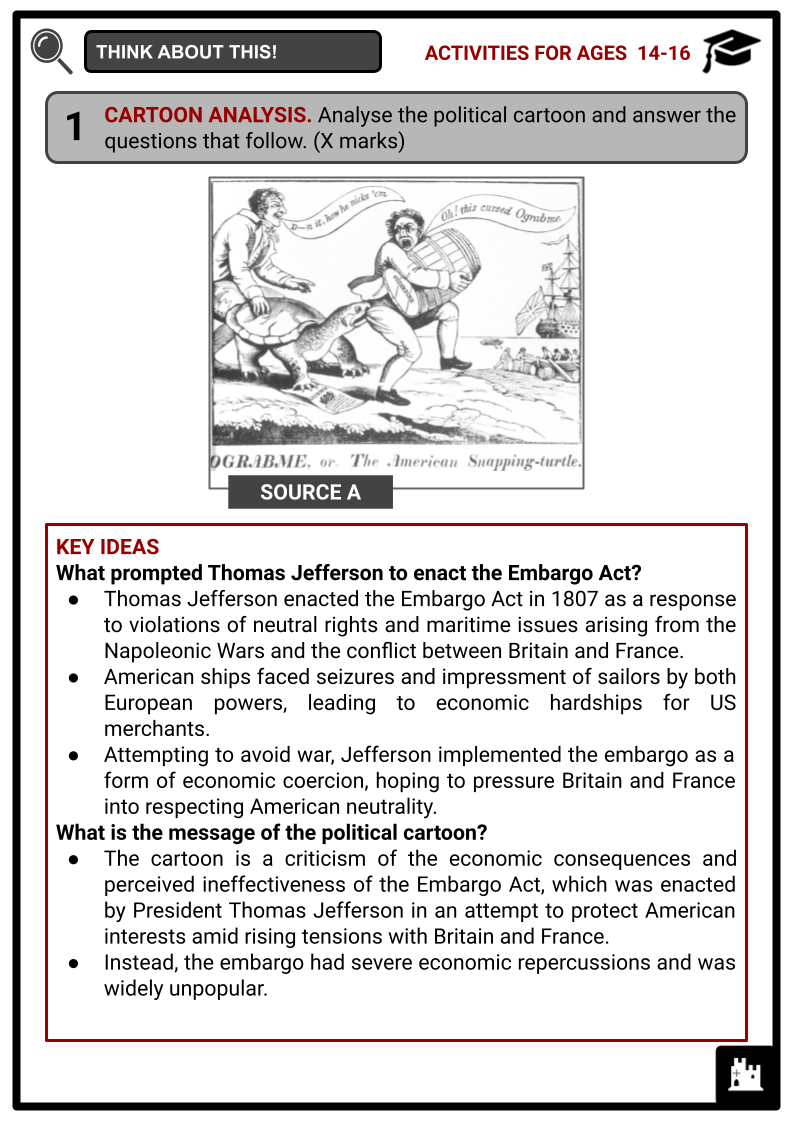
Summary
- Early Life
- Rise to Politics
- Presidency
- Death and Legacy
Key Facts And Information
Let’s know more about Thomas Jefferson!
Thomas Jefferson, an American statesman, diplomat, lawyer, architect, philosopher and Founding Father, served as President of the United States from 1801 until 1809. He was the principal writer of the Declaration of Independence. Jefferson served as the country's first secretary of state under George Washington after the American Revolutionary War and as John Adams' second vice president before taking office as president in 1801.
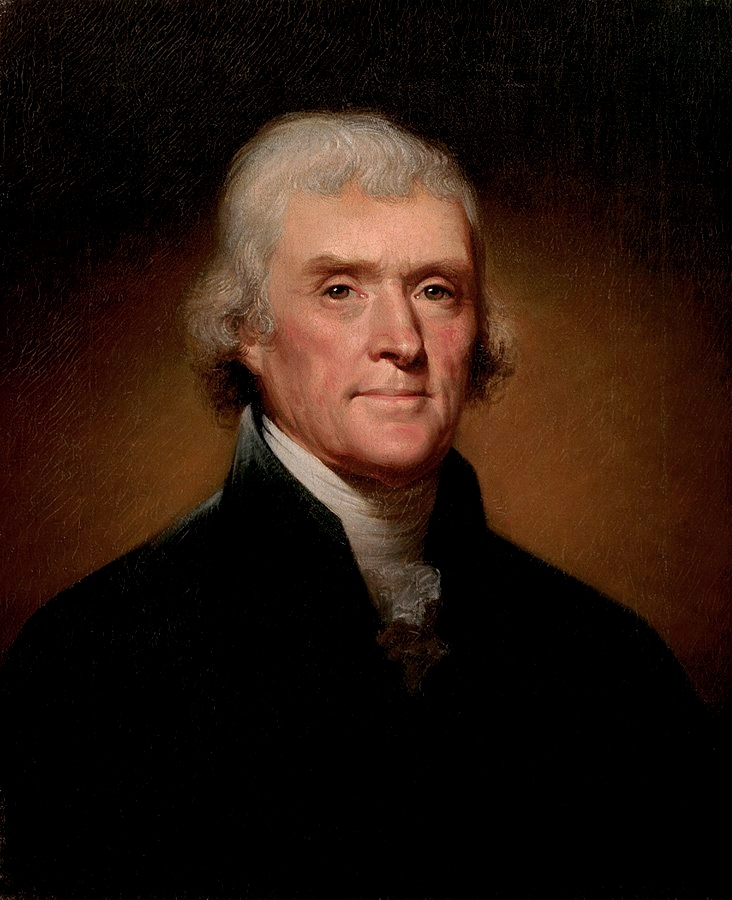
EARLY LIFE
- Thomas Jefferson was born on 13 April 1743, at Shadwell Plantation, a huge parcel of property in present-day Charlottesville, Virginia. His mother, Jane Randolph Jefferson, was descended from a well-known Virginia family, and his father, Peter Jefferson, was a prosperous farmer and surveyor. Their eldest son and third child, Thomas, had six sisters and one brother.
- After graduating from the College of William & Mary in Williamsburg, Virginia, in 1762, Jefferson is said to have liked studying for 15 hours every day and then practising the violin for many more hours. He continued his legal education under the guidance of renowned Virginia lawyer George Wythe (at the time, America lacked formal law schools). Wythe's students included statesman Henry Clay and future Chief Justice John Marshall.
- Jefferson started practising law in 1767. Known for his composed demeanour, Jefferson served in the House of Burgesses in colonial Virginia from 1769 to 1775. It was during this time that he wrote a pamphlet titled 'A Summary View of the Rights of British America', in which he argued that the British Parliament had no jurisdiction over the American colonies.
- Jefferson acquired the Shadwell estate after his father passed away while he was a teenager. Jefferson started preparing the site for the magnificent brick palace he would build there, named Monticello (meaning 'little mountain' in Italian), in 1768 by clearing a mountainside. The mansion and its ornate gardens were created by Jefferson, who was an enthusiastic gardener and architect.
- Throughout his life, he expanded on and renovated Monticello, filling it with exquisite furniture, intriguing devices and unique architectural features. Everything that occurred at the 5,000-acre property was documented by him, including daily weather reports, comments on the enslaved people and animals, and gardening journals.
- Jefferson married Martha Wayles Skelton, a young widow, on 1 January 1772. After relocating to Monticello, the couple had six children in all, of whom only two – Mary and Martha – lived to adulthood. Martha, Jefferson's wife, passed away in 1782 at the age of 33 as a result of complications during delivery. Jefferson never married again because he was so unhappy. He is speculated to have fathered further children, though, with Sally Hemings, one of his enslaved wives and his wife's half-sister.
According to Historian Lina Mann, in Jefferson's life, slavery was a controversial topic. He enslaved people all of his life, despite the fact that he supported individual liberty and once advocated for a plan for the gradual liberation of enslaved people in America. Furthermore, despite the fact that he said in the Declaration of Independence that 'all men are created equal', he argued that Indigenous people and whites could not live in harmony and freedom because of biological differences. Over the course of his life, Jefferson is reported to have held 600 enslaved people, having inherited 175 enslaved people from his father and father-in-law. Only a tiny percentage of them were set free by his will. The rest were sold after his passing.
RISE TO POLITICS
- Jefferson was chosen to serve as a representative to the Second Continental Congress in 1775, just as the American Revolutionary War was coming to an end. Despite his lack of popularity as a public speaker, Jefferson was a talented writer and, at the age of 33, was requested to prepare the Declaration of Independence.
- Prior to starting, he reviewed the document's contents with a five-person drafting committee that also included Benjamin Franklin and John Adams. On 4 July 1776, the 13 colonies approved the Declaration of Independence, which outlined their justification for wanting to be free from British control as well as the significance of individual liberties and rights.
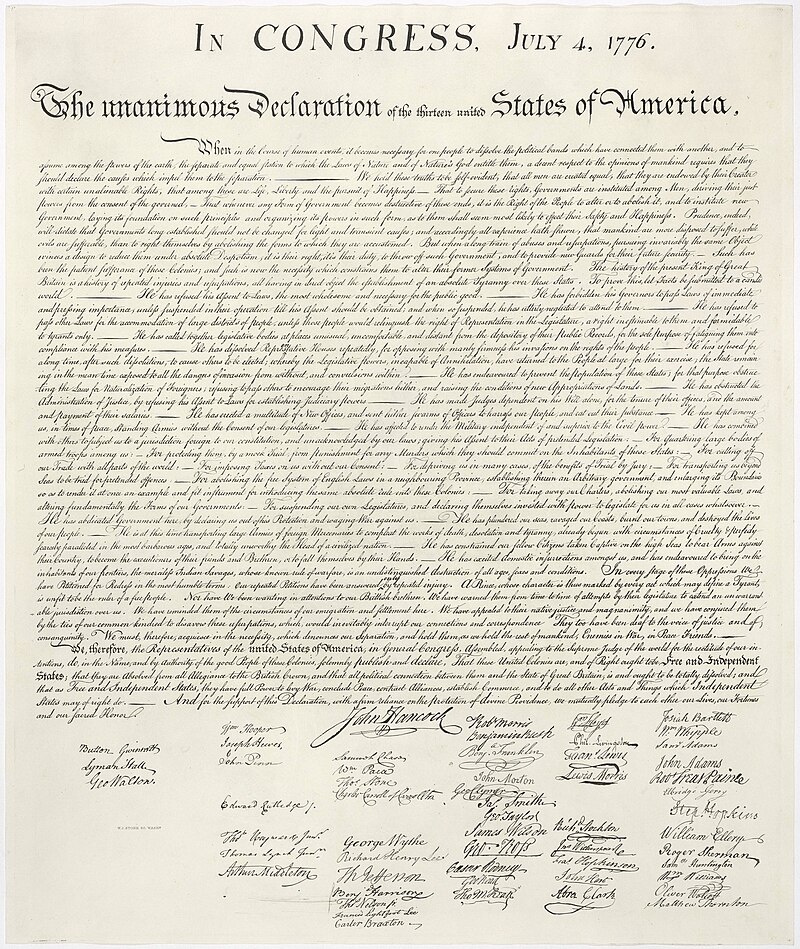
- Jefferson left the Continental Congress in the autumn of 1776 and won reelection to the Virginia House of Delegates, which was originally known as the House of Burgesses. One of the major accomplishments of his career, in his opinion, was the Virginia Statute for Religious Freedom, which he drafted in the late 1770s and which Virginia lawmakers finally ratified in 1786. It served as a model for the US Constitution's First Amendment. It aimed to safeguard people's freedom to practise any religion they desire.
- Jefferson held two terms as governor of Virginia, from 1779 to 1781, and a second term in Congress, which became formally known as the Congress of the Confederation from 1783 to 1784. He replaced Benjamin Franklin as the United States minister to France in 1785. Due to his obligations in Europe, Jefferson was unable to attend the summer 1787 Philadelphia Constitutional Convention, but he was kept updated on the events and went on to support the inclusion of a bill of rights and term limits for presidents.
- Jefferson took President George Washington's offer to serve as the young country's first secretary of state after arriving back home in the autumn of 1789. Jefferson disagreed with Alexander Hamilton, the Secretary of the Treasury, about foreign policy and their contrasting perspectives of the US Constitution. Jefferson co-founded the Democratic-Republican Party in the early 1790s in opposition to Hamilton's Federalist Party, which supported a powerful national government with extensive economic authority. Jefferson supported strong state and local governance.
PRESIDENCY
- When Jefferson fought against John Adams in the 1796 presidential race, he garnered the second-highest number of votes, making him vice president by virtue of the then-existing legislation.
- In 1800, Jefferson was once again facing off against Adams in the presidential contest that resulted in a fierce contest between the Democratic-Republicans and Federalists.
- Despite defeating Adams, Jefferson was tied with fellow Democratic-Republican Aaron Burr as a result of an election system error.
- Jefferson was elected by the House of Representatives when a tie vote was broken. Congress proposed the Twelfth Amendment to the US Constitution to prevent a recurrence of this circumstance.
- This mandated that the president and vice president be elected separately. In 1804, the amendment was approved.
- On 4 March 1801, Jefferson took the oath of office, marking the first presidential inauguration ever conducted in Washington, DC. Jefferson defied convention by walking to and from the ceremony rather than using a horse-drawn carriage.
- Accomplished during Jefferson's first administration, the Louisiana Territory was purchased from France in 1803, for a sum of $15 million. The Louisiana Purchase, which covered territory between the Mississippi River and the Rocky Mountains as well as the Gulf of Mexico and modern-day Canada, practically doubled the size of the United States at more than 820,000 square miles.
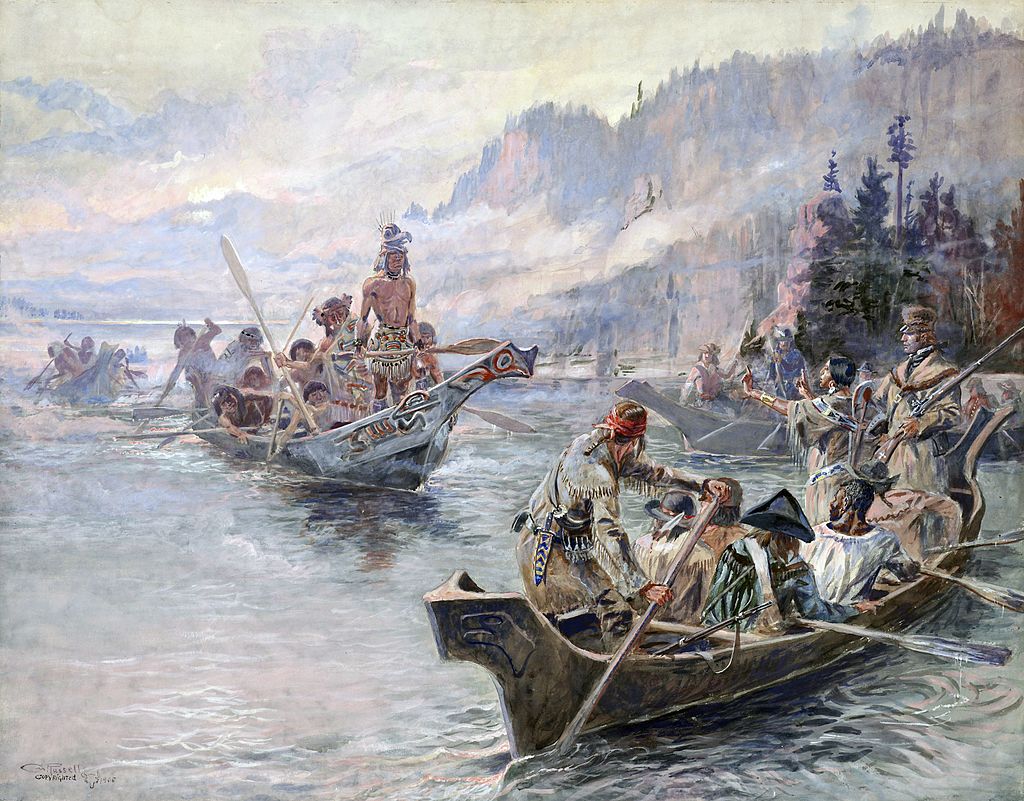
- William Clark and Meriwether Lewis were then hired by Jefferson to investigate the unexplored territory as well as the region beyond, all the way to the Pacific Ocean. From 1804 to 1806, Lewis and Clark's expedition — now known as the Corps of Discovery — provided important information on the western region of the continent's topography, Indigenous people, and animal and plant species.
- When Jefferson sought reelection in 1804, he defeated South Carolina's Charles Pinckney, a Federalist, with almost 70% of the popular vote and 161 electoral votes. Jefferson concentrated on attempting to keep America out of the Napoleonic Wars in Europe during his second time in office. However, Jefferson put into effect the Embargo Act of 1807 as the belligerent nations, France and Great Britain, started to harass American trade ships.
- American public opinion and the US economy were negatively impacted by the legislation, which prohibited foreign trade from entering US ports. It was abolished in 1809, and the United States ultimately engaged in combat with Britain in the War of 1812, despite the president's efforts to remain neutral. After Jefferson declined to seek reelection a third time in 1808, fellow Virginian and former Secretary of State James Madison took over as president.
DEATH AND LEGACY
- After leaving office, Jefferson lived at Monticello, where he pursued his many hobbies in gardening, music, architecture and reading. In addition, he was a founding member of the University of Virginia, which began instruction in 1825. In addition to overseeing the curriculum and architectural construction, Jefferson made sure the school had no religious connection restrictions for its students, in contrast to other American institutions at the time.
- Jefferson passed away at Monticello at the age of 83 during the 50th anniversary of the Declaration of Independence's adoption on 4 July 1826. Interestingly, on that same day, John Adams, a signatory to the Declaration of Independence, also passed away. Jefferson was laid to rest at Monticello. But because of the enormous debt the former president had accrued during his lifetime, his estate, furnishings and enslaved people were put up for sale after his passing. After a while, a nonprofit organisation bought Monticello and allowed the public to visit in 1954.
- Jefferson is still adored in America. His figure is etched in stone at Mount Rushmore and may be seen on the US cent. The Jefferson Memorial was dedicated on 13 April 1943, the 200th anniversary of Thomas Jefferson's birth, and is located in Washington, DC, close to the National Mall.
- Jefferson is acclaimed for creating the Declaration of Independence and being a key figure in the American Revolution.
- Regarded as a Renaissance man, he contributed to education and science.
- Symbolises individual liberty, democracy and republicanism.
- Advocated for increased suffrage and participatory democracy, leaving a lasting impact on his time.
- Historian Meacham asserts that he had the most influence in the first 50 years of the democratic republic.
- Since 1982, the Siena Research Institute poll has consistently ranks Jefferson among the top five American presidents.
- A 2015 Brookings Institution survey by the American Political Science Association named Jefferson as the fifth greatest president
Image Sources
- https://en.wikipedia.org/wiki/Thomas_Jefferson#/media/File:Official_Presidential_portrait_of_Thomas_Jefferson_(by_Rembrandt_Peale,_1800)(cropped).jpg
- https://en.wikipedia.org/wiki/United_States_Declaration_of_Independence#/media/File:United_States_Declaration_of_Independence.jpg
- https://en.wikipedia.org/wiki/Thomas_Jefferson#/media/File:Lewis_and_clark-expedition.jpg
Frequently Asked Questions
- Who was Thomas Jefferson?
Thomas Jefferson was one of the United States' Founding Fathers and the main author of the Declaration of Independence. He served as the third President of the United States from 1801 to 1809.
- What were Thomas Jefferson's contributions to American history?
Jefferson made significant contributions to American history, including drafting the Declaration of Independence, advocating for religious freedom, promoting education, and expanding the United States through the Louisiana Purchase.
- Did Thomas Jefferson enslave people?
Yes, Thomas Jefferson enslaved people throughout his life. At times, he expressed opposition to slavery, yet he also perpetuated the institution by having and managing enslaved individuals, including at his plantation, Monticello.
